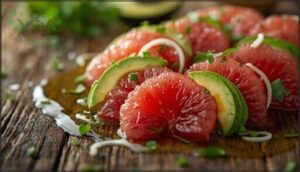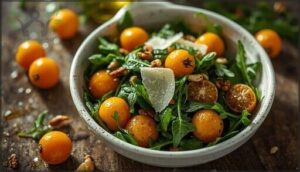This site is supported by our readers. We may earn a commission, at no cost to you, if you purchase through links.

You know that moment when your citrus tree finally produces more fruit than you can eat fresh? Suddenly, you’re staring at bowls of lemons, grapefruits, and kumquats, wondering how to use them before they shrivel.
The good news is that homegrown citrus fruit recipes can transform your harvest into dishes that taste nothing like store-bought versions. Fresh-picked citrus brings a brightness and complexity that you simply can’t buy in a bottle.
From salads that pop with tangy sweetness to main courses where citrus tenderizes and flavors meat, your homegrown harvest deserves better than basic lemonade.
The recipes ahead will help you make the most of every piece of fruit, whether you’re cooking dinner tonight or preserving your bounty for months to come.
Table Of Contents
Key Takeaways
- Homegrown citrus delivers brighter, more complex flavors than store-bought versions, making it worth preserving through freezing (which retains 90% of vitamin C for nine months) or proper refrigeration (extending freshness to 3-4 weeks).
- Citrus’s natural acidity works as a tenderizer and flavor enhancer in main courses like lime-braised pork shoulder and citrus-marinated seafood, while also cutting through rich proteins to create balanced dishes.
- Simple preparation techniques like rolling fruit before juicing (increasing yield by 20%) and using microplanes for zesting (avoiding bitter pith) help extract maximum flavor and nutrients from every piece of citrus.
- From grapefruit and avocado salads to Meyer lemon roasted chicken and candied peels, diverse recipes across all courses prevent waste while capturing your harvest’s peak flavors throughout the year.
Best Citrus Salads for Every Season
Citrus salads bring bright, fresh flavor to your table no matter the time of year. When you’re working with homegrown fruit, the possibilities go way beyond a simple wedge on the side of your plate.
Here are four recipes that pair citrus with seasonal ingredients for salads that taste as good as they look.
Grapefruit and Avocado Salad
This Texas icon pairs ruby red grapefruit with creamy avocado for a salad that’s both stunning and satisfying. You’ll get 31% of your daily vitamin C plus healthy fats that help your body absorb nutrients.
Segment the grapefruit for the best texture, slice your avocado thin, and finish with olive oil and a hint of shallot. For an enhanced flavor, consider using extra virgin olive oil in the dressing.
Mixed Greens With Citrus Vinaigrette
Craving something lighter? This salad delivers big flavor with spring greens, orange slices, and a punchy citrus vinaigrette. You’ll get 150 calories per serving plus 7% of your daily fiber.
Fresh orange juice, olive oil, and white balsamic vinegar create the perfect balance. Toss in pomegranate arils or toasted hazelnuts for extra texture, and serve it alongside roasted pork or steak. Each serving contains about 8 grams of net carbs.
Citrus and Fennel Winter Salad
When winter citrus season peaks, pair tangy oranges and grapefruit with crisp fennel for a revitalizing change. This citrus salad brings 152 calories and 27% of your daily vitamin C per serving.
The fennel’s mild licorice flavor combinations play beautifully against sweet citrus, while a simple olive oil vinaigrette highlights both seasonal ingredients. Toss in pistachios for crunch, and you’ve got nutritional benefits with serious taste impact.
Kumquat and Arugula Salad
Peppery arugula meets sweet kumquats in this citrus salad that’s packed with nutritional benefits. Eight kumquats deliver serious fiber to help digestion, while two cups of arugula give you 36% of your daily vitamin K.
Toss with pine nuts, Parmesan, and olive oil vinaigrette for flavor combinations that sing.
This fresh fruit salad comes together in just 15 minutes during harvest season.
Flavorful Main Courses With Homegrown Citrus
Citrus can turn your everyday mains into something memorable. The bright acidity cuts through rich proteins like chicken, pork, and seafood, while adding layers of flavor you just can’t get from a bottle.
Here are four recipes that put your homegrown citrus to work in dishes you’ll want to make again and again.
Dutch Oven Whole Roasted Chicken With Meyer Lemon
Roasting a whole chicken in a Dutch oven reveals delightful citrus flavors when you add Meyer lemon. This sweeter, less acidic citrus variety infuses the meat with floral notes while keeping it moist.
Here’s what makes this chicken recipe shine:
- Meyer lemon flavor brightens every bite without overwhelming tartness
- Dutch oven technique ensures crispy skin and tender meat through even heat
- Herb pairing ideas like rosemary and thyme complement citrus perfectly
The result? A 489-calorie serving packed with protein and nutritional benefits.
Grilled Halibut With Citrus Butter
With grilled halibut and citrus butter, you’re creating a flavor profile that balances mild fish with tangy brightness. Try tangerine or lemon zest mixed into butter with fresh sage for citrus butter variations.
This seafood recipe delivers 43g of protein and vitamin C in one citrus-based dish. Grill your halibut on citrus slices at 375°F for tender results, then pair with salads or vegetables for serving suggestion ideas.
Lime-Braised Pork Shoulder
Slow-cooked pork shoulder transforms with lime juice, creating tender meat that practically melts off the bone. You’ll marinate your pork shoulder for at least three hours, though overnight works better for citrus marinades and deep flavor pairings.
- Use 1/2 cup lime juice with garlic and cumin for citrus flavors
- Braise at 250°F for 4-6 hours until fork-tender
- Serve lime-braised meats in tacos or over rice
- Get over 100g protein per serving with great nutritional value at under $3 per plate for cost analysis
Citrus-Marinated Seafood Skewers
Fresh shrimp or fish skewers soak up citrus marinade beautifully, though you’ll want to watch your timing. Combine orange, lemon, and lime juices with olive oil and herbs, then marinate your seafood for just 30 minutes to an hour. The marinade’s acid can turn protein mushy if left too long.
Thread onto skewers and grill over medium-high heat for perfect citrus-based recipes.
Easy Citrus-Inspired Desserts
After you’ve mastered citrus in salads and main dishes, it’s time to explore the sweet side of your harvest.
These desserts capture the bright, tangy flavors of homegrown citrus without complicated techniques or hard-to-find ingredients.
From buttery tarts to classic bars, each recipe turns your fresh fruit into something worth celebrating.
Grapefruit Tart With Almond Crust
If you want something light yet indulgent, this grapefruit tart delivers. The almond crust tips start with toasted flour for deeper flavor, while grapefruit curd secrets include chilling for at least six hours. Tart topping ideas range from toasted coconut to whipped cream.
These citrus recipes shine in seasonal variations, and healthier options swap refined sugars. Desserts with citrus never tasted better.
Classic Lemon Bars
These lemon bars prove that simple ingredients make memorable desserts. You’ll get buttery crust texture paired with just-right filling tartness that’ll brighten any table.
Here’s what makes them work:
- Bake the shortbread base first at 350°F for 20 minutes
- Pour tangy lemon filling over warm crust
- Cool completely, then refrigerate two hours
- Dust with powdered sugar before serving
Dietary adaptations like gluten-free flour swap in easily without sacrificing that classic sweet-tart balance.
Orange Olive Oil Cake
This Mediterranean-inspired dessert swaps butter for extra virgin olive oil, giving you amazing moisture that lasts for days. Orange zest and juice deliver bright citrus flavor while the olive oil adds richness with heart-healthy monounsaturated fats.
Beat your eggs until fluffy, fold in dry ingredients gently, then bake at 350°F for 40 minutes. You’ll get tender cake texture with far less saturated fat than traditional recipes.
Candied Citrus Peel Treats
Turn leftover peels into sweet, chewy citrus bits perfect for snacking or topping desserts.
Blanch orange, lemon, or grapefruit peels 2-4 times to reduce bitterness, then simmer in sugar syrup at 230°F until translucent. After drying, toss in granulated sugar.
Store these candied citrus peel treats in airtight containers for up to two months, or freeze for three months.
Refreshing Citrus Drinks and Juices
Nothing beats the pure, bright flavor of citrus when you’re thirsty. Whether you’re squeezing your backyard lemons for a pitcher of something cold or mixing up a special drink for friends, homegrown fruit makes all the difference.
Let’s look at some easy ways to turn your citrus harvest into thirst-quenching beverages you’ll want to make again and again.
Homemade Lemonade and Limeade
Beyond their classic appeal, homemade lemonade and limeade let you control sugar content while maximizing health benefits from fresh citrus drinks. A typical recipe combines lemon or lime juice with water and sweetener—adjust ratios to suit your taste.
These beverage recipes deliver vitamin C and antioxidants, and market trends show growing interest in natural preparation tips that reduce added sugars compared to store-bought options.
Fresh Citrus Juice Blends
Mixing citrus fruits unlocks exciting flavor combinations—try orange with grapefruit for a sweet-tart balance, or blend tangerine and lemon for bright, zesty notes.
These fresh juice recipes boost vitamin C content, while preparation techniques like cold pressing preserve nutrients best when you drink within 48 hours.
Market trends favor low-sugar blends, and the health impacts include better hydration and antioxidant support from these healthy drink recipes.
Citrus-Infused Sparkling Water
You’ll love how sparkling water with citrus fruits transforms plain hydration into a revitalizing drink that’s both delicious and functional. Try pairing lemon with lime juice, or experiment with orange and basil-infused simple syrup for recipe variations that beat sugary cold drinks.
This market growth favorite delivers vitamin C and promotes satiety, making it perfect for those seeking sugar alternatives in their fresh fruit beverages.
Creative Citrus Cocktails
With your homegrown citrus, you can craft creative cocktails that tap into consumer trends favoring exotic citrus like yuzu and blood orange. Try a gin cocktail with fresh Meyer lemon or a citrus liqueur splash—these drinks with citrus offer health benefits from vitamin C while riding market growth in craft beverages.
Cocktail recipes using real fruit deliver authentic flavor that bottled mixes can’t match.
Tips for Using and Storing Homegrown Citrus
Growing your own citrus means you’ll have plenty of fruit to work with, and knowing how to handle it makes all the difference. Simple techniques like proper juicing and zesting can help you get the most flavor out of every piece.
Let’s cover the basics of using, preserving, and storing your homegrown citrus so nothing goes to waste.
Juicing and Zesting Techniques
Getting the most from your citrus fruits starts with the right techniques. Rolling citrus on the counter before cutting can boost juice yield by up to 20%, while proper zesting tools—like microplanes for fine lemon zest or traditional zesters for strips—reveal intense flavor without bitterness. Here’s how to master both:
- Use a microplane or grater for baking and dressings needing fine zest
- Roll fruits firmly before juicing to rupture juice sacs and get the most out of yield
- Cut citrus crosswise and squeeze gently to prevent spray waste
- Remove only colored peel when zesting, avoiding bitter white pith
Fresh juice preparation preserves up to 90% of vitamin C compared to bottled alternatives. The juice acidity in citrus juice naturally enhances marinades and dressings, while zest adds aromatic oils that enrich your culinary impact. Whether you’re using a manual juicer for small batches or an electric model for larger quantities, these techniques help you draw out every drop of flavor from your homegrown citrus fruits.
Preserving Citrus: Freezing and Canning
Freezing citrus juice and segments at -18°C or below locks in up to 90% of vitamin C for nine months, making it perfect for year-round citrus recipes. Flash freezing helps maintain freezing quality better than slow methods, while proper home practices guarantee nutrient retention in your citrus-based recipes throughout citrus season.
For canning citrus-based dishes, hot water bath methods work well since citrus fruit naturally has high canning acidity that prevents safety risks.
Storing Fresh Citrus for Longevity
Want your fresh citrus fruit to stay bright and juicy for weeks? Keep whole citrus fruits at room temperature for up to a week, or switch to refrigeration methods—storing them loose in the fridge extends freshness to 3-4 weeks.
Humidity control matters too; aim for 85-90% to prevent drying out. Use mesh bags as packaging options for better airflow, and remember that proper storage aids nutrient preservation in your fruit intake.
Nutritional Benefits of Citrus Fruits
Your citrus harvest packs serious nutritional firepower. One orange delivers nearly 100% of your daily vitamin C requirement, while flavonoids provide antioxidant power that aids heart health and disease prevention.
Your citrus harvest delivers nearly a full day’s vitamin C in one orange, plus flavonoids that protect your heart and fight disease
The fiber aids digestive effects, and citrus recipes preserve these benefits beautifully.
This food and nutrition combination makes healthy eating delicious—essential nutrition information for anyone growing their own fruit.
Frequently Asked Questions (FAQs)
How do I grow citrus trees at home?
Like ancient Roman gardeners, you’ll need six to eight hours of daily sunlight, well-draining soil with organic matter, and proper watering techniques to grow thriving citrus trees that produce delicious organic produce.
When should I harvest homegrown citrus fruits?
Harvest timing depends on ripeness indicators like bright color, firmness, and weight. Most citrus fruits mature from late fall through spring, with regional variations.
Taste-test for peak flavor, as sweetness won’t improve off the tree.
What pests commonly affect citrus trees?
Your trees face several challenges, including citrus leafminer, aphid infestations, scale insects, citrus red mites, and fruit fly control issues.
These pests damage leaves, stems, and developing fruit, reducing your harvest for fresh salads and citrus recipes.
Can citrus trees grow indoors or in containers?
Picture a sunny windowsill transforming into your personal citrus grove. Indoor citrus varieties like dwarf Meyer lemons and kumquats thrive in containers with proper sunlight requirements, temperature control, container growing mediums, and pest management strategies.
How do I make citrus marmalade from scratch?
Making citrus marmalade from scratch starts with washing and peeling oranges, lemons, or grapefruit. Boil zest and fruit with water, add sugar, then cook to 220°F. Process in sterilized jars for preservation.
Conclusion
The best way to avoid wasting citrus is to use too much of it. When you cook with homegrown citrus fruit recipes, you’re not just clearing counter space—you’re capturing flavors at their peak. Each dish becomes a snapshot of your harvest, whether it’s a salad that brightens Monday dinner or preserved peels you’ll enjoy in February. Your trees gave you this abundance. Now your kitchen gets to prove it was worth the wait.
- https://www.instagram.com/thishealthytable/
- https://www.appetizeraddiction.com/chocolate-covered-orange-peels/
- https://www.eatthismuch.com/calories/grapefruit-and-avocado-salad-with-ginger-cassis-dr-737328
- https://www.healthline.com/nutrition/avocado-nutrition
- https://citrusindustry.net/2022/02/10/fruit-and-vegetable-consumption-severely-lacking-in-u-s-adults/











